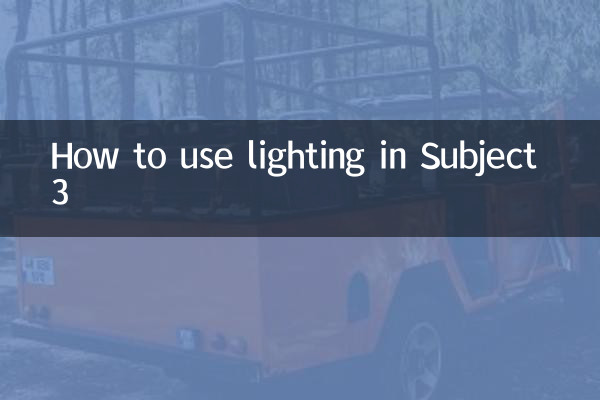How to use lighting in Subject 3: Detailed operation guide and analysis of frequently asked questions
The subject three test is an important part of the driver's license test, among which light operation is one of the required items. Many students are prone to making mistakes in the use of lighting, leading to failure in the exam. This article will introduce in detail the use of lighting in subject three, and combine it with the hot topics and hot content on the Internet in the past 10 days to help candidates pass the exam in one go.
1. Basic requirements for subject 3 lighting operation

The subject three lighting test mainly examines students’ ability to correctly use vehicle lights at night or under low visibility conditions. During the exam, candidates need to complete the corresponding lighting operations according to the voice prompts. The following are the basic requirements for light operation:
| Action items | Correct operation |
|---|---|
| Low beam | Turn on the low beam headlights to ensure that the light covers the road ahead |
| High beam | Turn on high beam headlights when there are no oncoming cars or pedestrians |
| Alternate high and low light | Quickly switch between high and low beams to alert other vehicles or pedestrians |
| Position lights and hazard warning flashers | Turn on when vehicle breaks down or is temporarily parked |
2. Common mistakes in subject 3 lighting examination
According to the hot content on the Internet in the past 10 days, many students are prone to making the following mistakes in the lighting exam:
| Error type | Error reason | Solution |
|---|---|---|
| Failure to turn on the lights in time | Sluggish response to voice prompts | Familiarize yourself with voice commands in advance and respond quickly |
| Confusion between high and low beams | Unfamiliar with light switch location | Repeat operations during practice to form muscle memory |
| High beam is not turned off | Forgot to switch back to low beam | Check the light status after operation |
3. Detailed explanation of the lighting operation steps for Subject 3
1.Check the lights before starting: Make sure all lights are turned off to avoid penalty points due to lights not being turned off during the exam.
2.Follow voice prompts: The examination system will randomly play lighting operation instructions, and candidates must complete the corresponding operations within 5 seconds. The following are common voice commands and operation examples:
| Voice command | Correct operation |
|---|---|
| “Driving through sharp bends at night” | Alternate high and low beam twice |
| "Meeting with motor vehicles at night" | Turn on low beam headlights |
| "Temporary parking on the roadside at night" | Turn on your profile lights and hazard warning flashers |
3.Turn off the lights after the exam: After completing all light operations, all lights need to be turned off to ensure that the vehicle is in a safe state.
4. Answers to popular questions on the entire network
According to recent Internet hot spots, the following are the issues that students are most concerned about:
Q1: What content will be tested in the lighting examination of Subject 3?
A1: The test content mainly includes the use of dipped beam, high beam, alternating high and low beam, position lights and hazard warning flashers. Specific instructions are randomly generated, but the operation logic is fixed.
Q2: Will lighting operation errors result in direct failure?
A2: Lighting operation is the first item of the subject three exam. If the operation error occurs more than 2 times, the system will determine the failure. So be sure to take it seriously.
Q3: How to quickly remember lighting operations?
A3: You can practice through simulation or use light operation formulas, such as "low beam when meeting another car, alternating overtaking, double flash when parking".
5. Summary
The lighting test of Subject 3 may seem simple, but details determine success or failure. Through repeated practice and familiarity with the operating procedures, candidates can easily master the lighting usage skills. I hope the detailed analysis in this article can help you pass the exam smoothly!

check the details

check the details